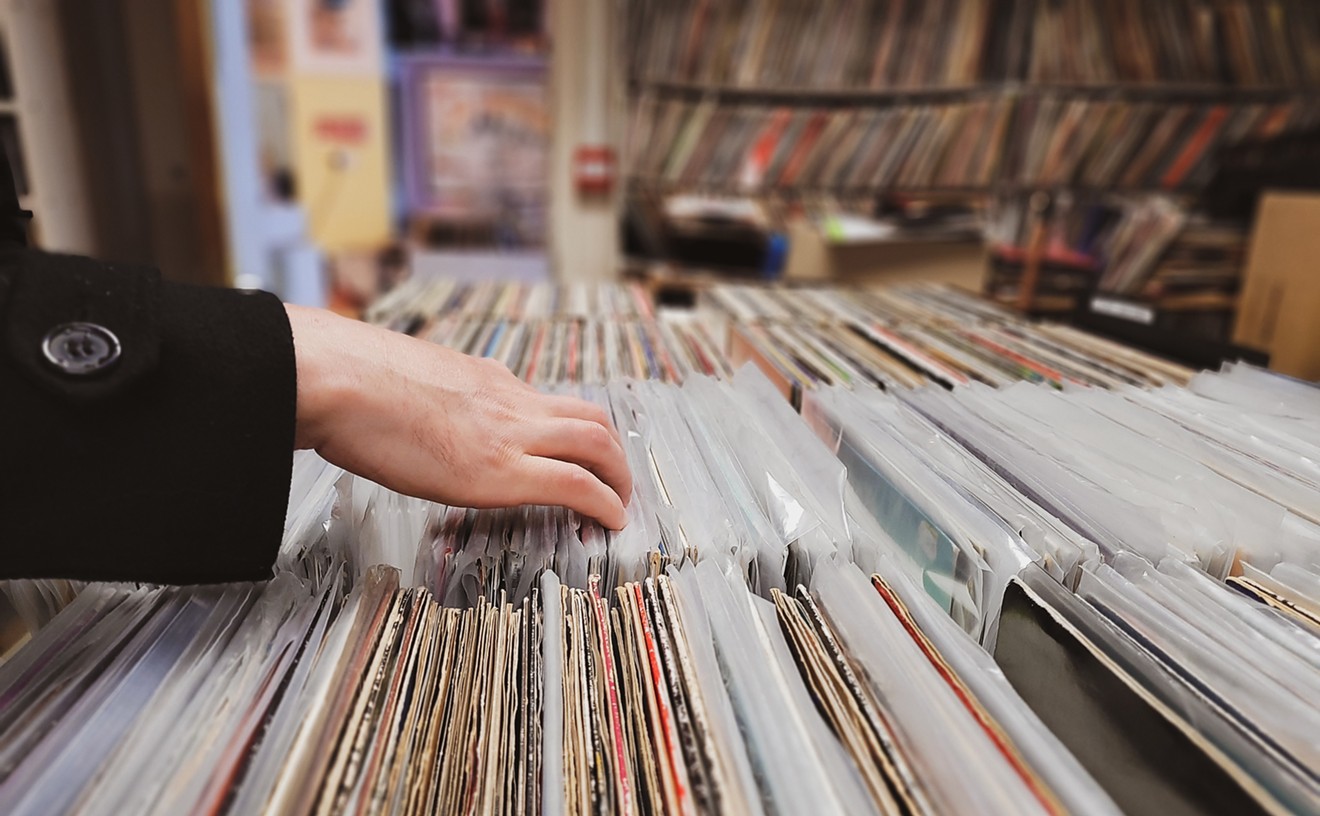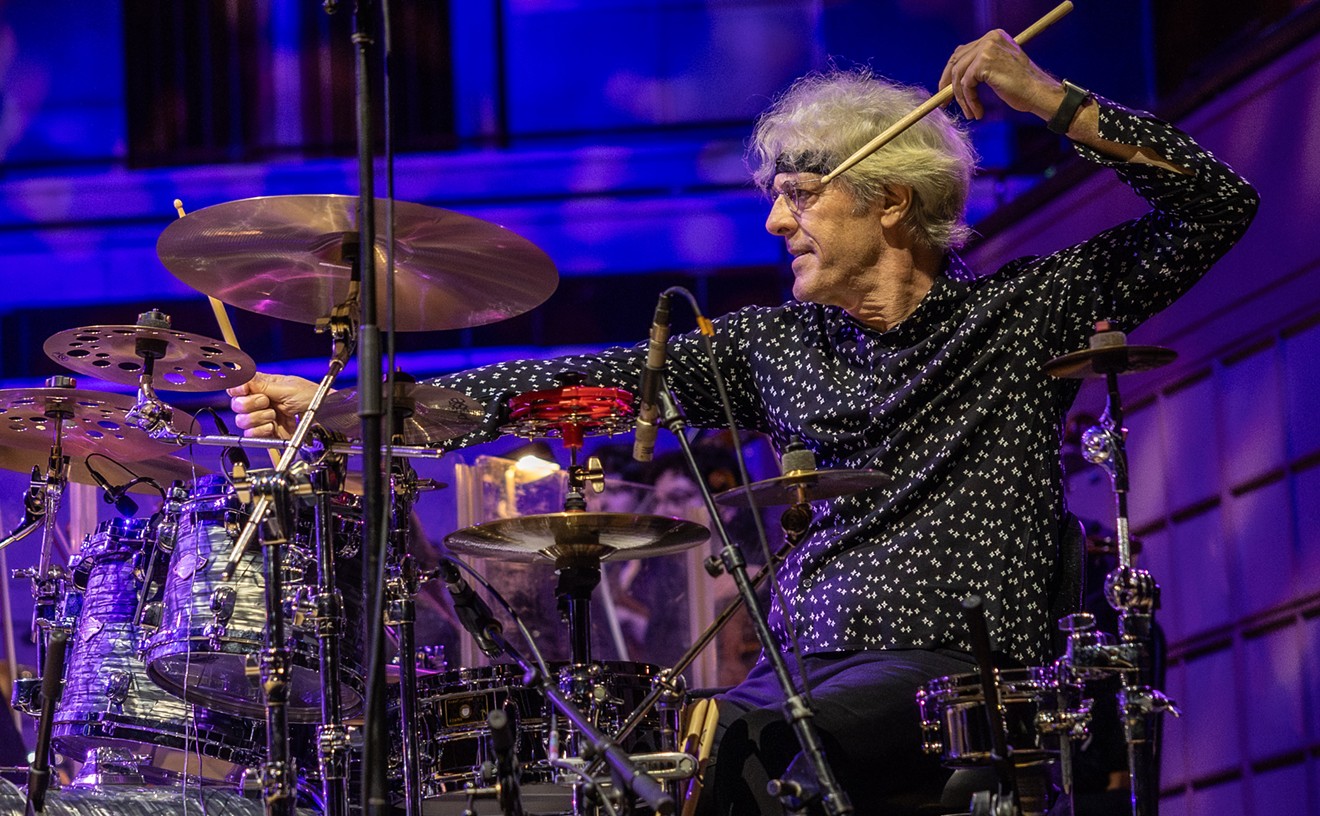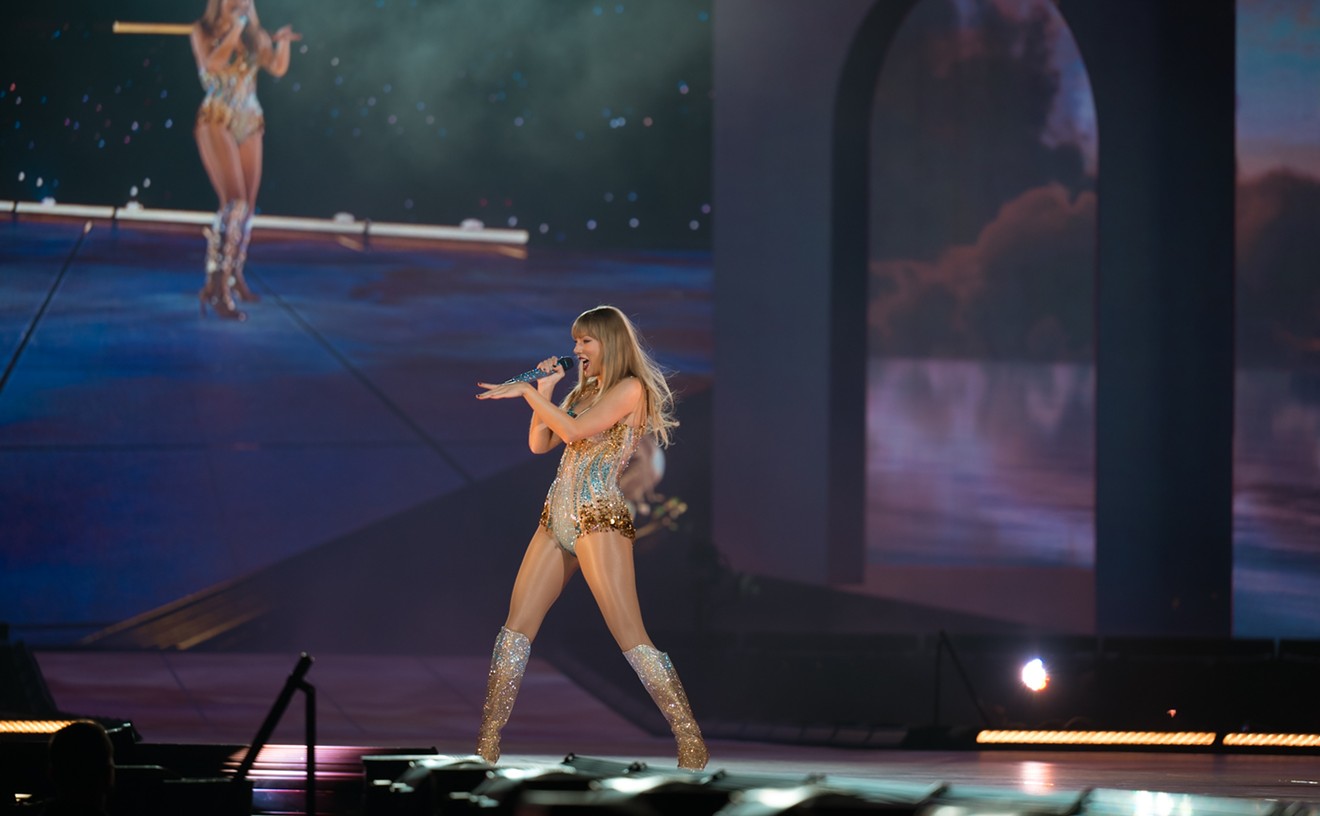On the walls are myriad celebrity shots, mementos of his career: Bland arm in arm with General Norman Schwarzkopf, Eddie Vedder, Billy Idol, and President George Bush, for which he wore his SFW ("so fucking what") hat. Nearby a large color picture lies flat; in it, Billy Gibbons, beard trailing behind him like a tail, crouches knock-kneed, bending the strings of a guitar that nearly drags the ground.
They're the fruits of a long, productive endeavor that has seen Bland shooting the likes of ZZ Top (he did the individual shots on the inside of Rhtyhmeen's CD booklet), the Reverend Horton Heat (the baptism shot from The Full-Custom Gospel Sounds of the Reverend Horton Heat), and others such as Ronnie Dawson, Deep Blue Something, Tablet, and 66. His work has been on the covers of national mags like Guitar World (Pantera) and Guitar School, and he has done more Buddy covers than you can shake a stick at, but his most fascinating work is his least accomplished, the pictures he took of the people he hung out with and the bands he liked from 1984 until Deep Ellum became commercially viable and assumed the form in which we now know it; a retrospective collection of his work from that period, Deep Ellum: The Formative Years, 1984 to Present, will be on display at the Art Bar starting October 17.
In '84, Bland was going to UTA and working for small suburban papers like the Las Colinas Journal--just another kid trying to make a name for himself in a hard-to-crack business, learning as he went.
"I always liked music," Bland recalls. He was turned on to the developing Deep Ellum scene by a punk classmate who took him to the Twilight Room, one of Dallas' first alternative venues, where he was exposed to bands like T42 and True Sounds of Liberty. "I was working on the photo essays and stuff you need to start a portfolio," Bland says. "I just started shooting pictures...People were real loose, like, 'Sure, go ahead.'"
He was hanging out in places like the fabled Theatre Gallery, winging it to the extreme. "I didn't even have a flash...Half the time I couldn't afford film. I'd shoot however many frames I had left on a roll and then hang out. I started out shooting live shots, then staged band pictures that I'd try to sell. At some point I started shying away from doing it as a school thing and just started doing portraits of people in their element, which I always liked to do." His heroes included Annie Leibowitz and the photogs for Life magazine. "I wanted people to be able to feel the vibe, to realize what it was like," he explains.
His approach was dictated more by friendship and association than a desire to "cover the waterfront"; thus, some bands like Decadent Dub Team, the Peyote Cowboys, and the Buck Pets are very well represented, while others, like the New Bohemians, are almost completely absent. "I think I have, like, one picture of Edie [Brickell]," he says. He also snapped acts like the Red Hot Chili Peppers and Jane's Addiction, then simply road bands who would come through town and play for a fin. "Deep Ellum was the only place they could play then," Bland remembers.
Looking at his pictures, one is struck by several things. For one, unlike today, with tattooed and pierced scenesters acutely aware of fashion dos and don'ts clogging the sidewalks and writing nasty things about each other in restrooms, the Deep Elluments of the mid-'80s seem ordinary to the extreme: a group of slightly wrinkled, mildly stunned folk in shorts and T-shirts with an occasional punky style horse here and there to break the monotony. Another is the incredibly spare, junky vibe of the area at that time.
Bland, who helped document the movement by shooting photos for such germinal albums as End Over End's The End and the Dude, You Rock! compilation, has mixed feelings about those days. "There were so many bands then, but now it's ridiculous," he says with a touch of wonder. "You couldn't make any money, and no one had even thought about getting signed. It's such a business now, but I'm glad that the amenities are there now. Back then, nobody had any permits or licenses, so if you wanted beer or cigarettes, you had to go all the way down to the 7-Eleven at [Fitzhugh and] Columbia...There was no air-conditioning, so everybody would crowd in to see a band play, then go back outside until the music started up again."
If you were there, you may very well see yourself dancing in front of the Big Boys on some hot, sweaty, long-ago night (you may not, however, want to admit it) or thrill to forgotten images: the late, lamented Killbilly in dresses, or Horton Heat without tattoos. Even if you're a newcomer to Deep Ellum, you'll appreciate the fascinating, fly-in-amber quality to Bland's work, moments and people--and a place--frozen in time forever. Either way, you'll have to agree that Bland accomplished one of his basic goals. "When you see the picture," Bland explains, "I want you to hear the music."
Deep Ellum: The Formative Years, 1984 to Present will be on display at the Art Bar (Crowdus and Main) in Deep Ellum for approximately six weeks beginning October 17.
I'd like to teach the world
Congratulations to Dr. Malena Kuss of the University of North Texas' College of Music: After a decade of working with International Music Council of UNESCO (United Nations Scientific and Cultural Organization) on its Universe of Music, the Latin American music expert has been named the executive editor of the 12-volume work. The Universe is not an encyclopedia or a history, but the presentation of a "universe of music" that would trace the entire flow of music and its influence throughout history; think of it as a 3-D model of the DNA of world music, an analogy that makes Dr. Kuss laugh.
The study, which will be published by the Smithsonian Institution Press in 1997, breaks with most analytical works on world music by actively seeking native intelligence on regional forms. "We wanted to avoid the situation that has existed before, where the Germans or Americans write the history, because when the West uses its jargon, it immediately changes things," she explains. "So we proposed that native scholars contribute, because we want to project the native sense of things--the way they talk about it.
"We're most concerned with covering things in depth," she continues. "There's a proliferation of [musical] dictionaries these days, but while they're very good, there's a tendency to get canned definitions because of space considerations...Places like Cuba, Bolivia, or Aruba get little attention." The scope of the work is unprecedented; each volume covers a distinct region and boasts contributions from more than 120 local experts.
Street Beat welcomes your e-mail tips, tales, kudos, catcalls, spews, and news at [email protected].










